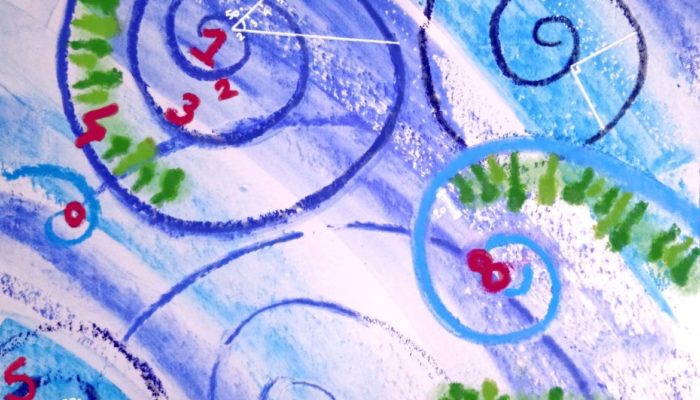
On November 1st 2019, Louise Arnal, a PhD candidate at the University of Reading and the European Centre for Medium-Range Weather Forecasts (ECMWF), had her art exhibition opening event at The Museum of English Rural Life (Reading, UK). This exhibition was part of her PhD thesis on hydrology, and was called “Gambling with floods?”
For me, it was the first time I saw a PhD thesis in hydrology that includes an art exhibition. Louise is ready to tell us how it happened and why:
Louise Arnal: “Most PhD students will experience challenging moments during their PhD. My way to cope with these harder times was to bring together two of my passions: science and art. I started by making small doodles of work-related activities, and gradually, I began making pieces to communicate my PhD topic to a wider audience. I call myself “a scientist by training, with a lifelong love of art”. I grew up in a family of artists and art has always been a part of my life. But when I started studying science at University, I put art aside, thinking I had to focus on the science I do. Ironically, art is the reason I am (almost) a Dr. today.
As time went by, art developed into more than a simple and fun tool to communicate my research. And a beautiful symbiosis between the science and the art I do emerged. Through my art, I got a new perspective on science, learning to write better and clearer scientific papers, and challenging the way I (and we as a scientific community) have been tackling challenges in the field. Science has in turn inspired my artistic practice. I find the combination of science and art (SciArt) a fascinating process and want to pursue a career in this field. As such, creating a SciArt piece for my PhD thesis seemed rather natural..
My PhD art piece, “Gambling with floods?”, is an immersive multimedia and multi-sensory installation. By making the spectator an actor at the heart of the metaphorical flood forecasting machine, this piece aims to provoke and question the interface between humans and machines in the anticipation of floods, and the extent to which floods can be predicted in the noisy chaos of nature. Through this installation, I wanted to allow a wide audience to explore the metaphorical world of my PhD and of flood forecasting, including them in the field’s latest “discussions”.

Louise Arnal on her art exhibition opening event at The Museum of English Rural Life (Reading, UK)
It took a year between this piece’s conceptualisation and its exhibition at the museum. I knew what I wanted to communicate from the start, but how I wanted to communicate it was the biggest challenge for me. It required a huge step back for me to be able to explore a field I had become so familiar with in a new light, to be able to grasp the essence of it in my installation.
Another challenge has been to find a compromise between the concept in my mind and its technical feasibility (limited by the budget I had). This installation was created through a collaboration with Stuart Mitchell (Senior Analyst at the ECMWF), who put together the entire technical part of the installation.
Finally, another great challenge has been to formally incorporate this piece as one of my thesis chapters (from finding a museum space to exhibit it and making sure my PhD viva and exhibition overlapped, to contacting people higher up the chain at the University to ask whether this was allowed and finding out that they were as unsure as I was about it). This is not a very common occurrence and it took some courage and a lot of improvisation along the way.
For me personally, this exhibition was a success the moment it was installed at the museum and an official chapter of my PhD thesis. This is my first ever SciArt exhibition and a very exciting personal challenge, which has formed my stepping stone into the world of SciArt. Hopefully, by successfully incorporating this SciArt exhibition as one of my thesis chapters (my PhD viva examiners really appreciated the fact that I had), this has and will inspire future PhD students to adopt somewhat non-conventional tools into their scientific research. And the whole process behind it will hopefully become more transparent and simpler with every new PhD student at the University of Reading (and elsewhere) aiming to do that. Incorporating art into my scientific PhD thesis has not only helped me through harder times during my PhD (and at the end of the day to defend it successfully). It has also given me a new perspective on science that I would not have gained in any other way!
I would like to acknowledge the valuable help of Stuart Mitchell with the technical installation. I would also like to thank the guidance and support I received from my family, friends, colleagues, artists and scientists during this journey. This exhibition received funding from the EU Horizon 2020 IMPREX project (641811) and the University of Reading Vice-Chancellor endowment funding for events, and support from The MERL, ECMWF and the HEPEX community.”

Stuart Mitchell and Louise Arnal in the “Gambling with floods?” exhibition space
___
Find out more on Louise’s science and art blog
Louise’s thesis was supervised by Prof. Hannah Cloke and Dr. Elisabeth Stephens (U. Reading): Arnal, L. (2019) “The Art of Streamflow Forecasting over Europe”
